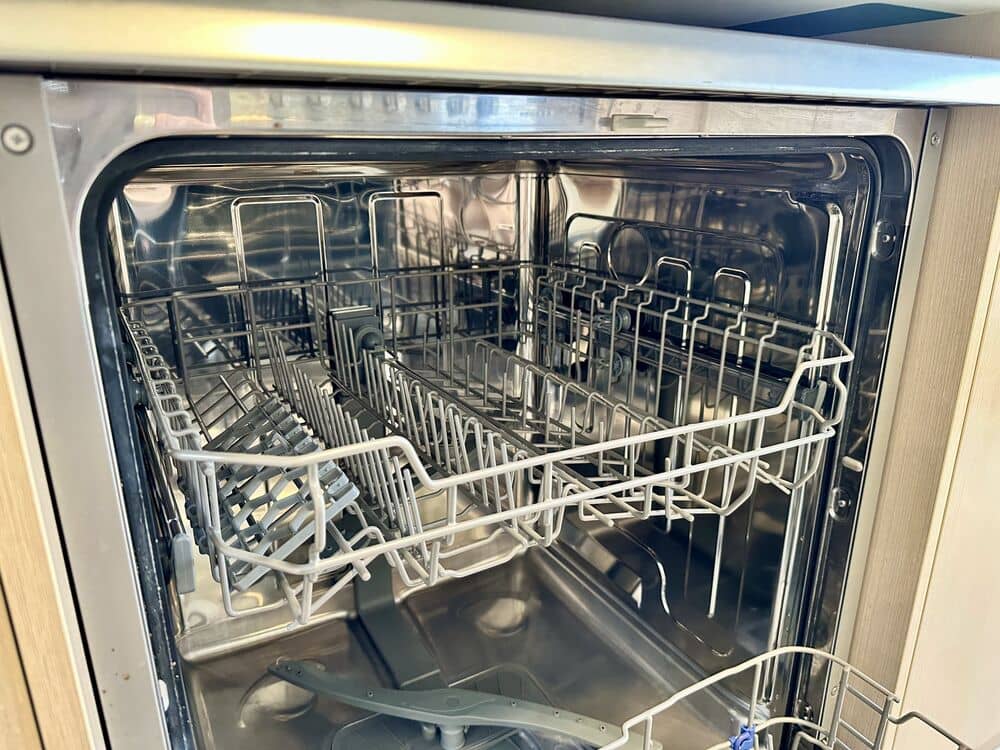It’s a kitchen nightmare – opening your dishwasher after a cycle, only to find the dishes are still dirty.
Maybe there’s soap scum all over the spoons, or maybe pieces of food are stuck to the plates. Either way, it’s clear: the dishwasher didn’t do its job.
After you’ve unloaded the dirty cutlery, check on your appliance.
Common reasons your dishwasher isn’t cleaning the dishes properly include:
- Clogged spray arms
- Dirty dishwasher filter
- Clogged dishwasher drain
- Detergent issues
- Broken soap dispenser
- Incorrect loading
- Faulty inlet valve
- Water supply issues
- Low water temperature
- Wrong cycle
It may feel like a dish-aster, but once you identify the cause of your faulty dishwasher, you can quickly fix it!
Then you’ll be back to clean dishes for all the yummy food in your kitchen.
Why is My Dishwasher Not Cleaning Properly?
One of the main reasons for a dishwasher not cleaning dishes is a dirty component – like the filter, drain, or detergent dispenser.
Regularly cleaning the dishwasher ensures everything is in good working condition.
Besides a dirty interior, how you use the dishwasher can also affect its efficiency. Here’s a rundown of common reasons we see for malfunctioning dishwashers!
1. Clogged spray arm
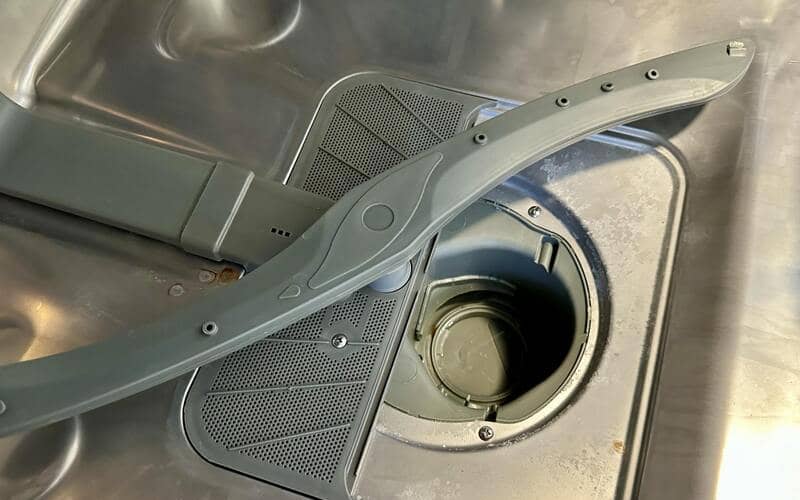
The dishwasher spray arms are responsible for blasting away stubborn grime and cleaning the dishes. They spin above and/or below the racks, with water coming out of tiny holes or nozzles (called jets).
Soap and food residue can get into those jets and block the water coming out. Hard water mineral deposits can also build up in the nozzles.
The usual spray of water then becomes a gentle sprinkle – resulting in dirty plates and utensils.
How to fix it:
Check the spray arms once a month and clean them if necessary.
Follow the owner’s manual for instructions on removing and cleaning the spray arm.
Usually, you can use a toothpick to remove any debris clogging the nozzles.
Alternatively, soak them in a 1:1 mix of vinegar and water to dissolve grease and light mineral buildup. Scrub them clean with some dish soap and a soft brush, then rinse thoroughly.
Reinstall the arms following the instructions and give them a spin to make sure they’re fully in place.
2. Dirty filter
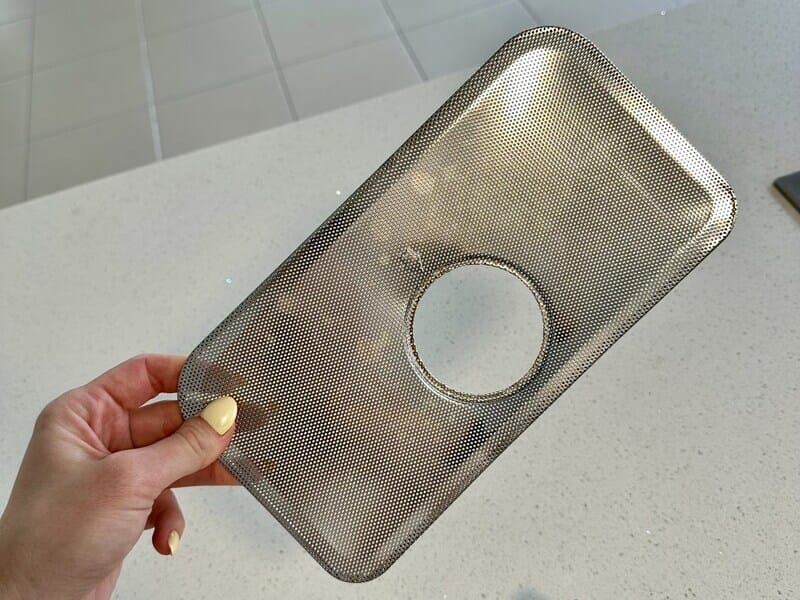
A dishwasher filter traps grease, food particles, and other residue after a wash cycle. This prevents the debris from clogging the drain hose or re-depositing onto your clean dishes.
However, that means the dirt builds up after several loads of dirty plates and utensils.
When you have a clogged dishwasher filter, the leftovers from dinner will stay stuck on the dishes even after washing.
How to fix it:
Clean the dishwasher filter regularly – about once a week if you run loads often.
(Yes, even a self-cleaning filter needs cleaning!)
Locate the filter at the bottom of the dishwasher tub, then remove it. Rinse the filter in warm water, then scrub it clean with a soft brush and some dish soap.
Check the manual for specific instructions on removing and cleaning the filter, since it can vary by model.
3. Clogged dishwasher drain
If your dishes are still dirty after a wash cycle and there’s standing water in the dishwasher, it’s likely the drain is clogged!
Food deposits, grease, and other debris can cause clogs and prevent the dishwasher from draining properly.
The pooling water can also cause funky smells or lead to mould, leaving you in dish-tress!
How to fix it:
Remove the dishwasher filter (and clean it!), then check the drain for any clogs or blockages.
You can try to remove any clogs with a mix of equal parts white vinegar and hot water. Leave it for 15 minutes to dissolve any residue.
If that doesn’t work, you may need professional help.
4. Detergent issues
Detergent is a key player in dish cleaning, but dish detergent is different from dishwasher detergent. Not all soaps are formulated for use in a dishwasher.
Even if you have the right detergent, though, improper use can lead to poorly cleaned dishes.
Too much detergent will leave soap scum, while too little won’t wash all the dirt off.
How to fix it:
Use the correct detergent and amount recommended for your dishwasher model.
Most will come in powder, liquid, or tablet form. The more important factor is that it has the cleaning power to tackle stubborn grease and stuck-on food!
Not sure how much dishwasher detergent to use? Here’s a quick reference:
- Powder detergent: 1 tbsp (or more as needed)
- Dishwashing liquid: 2 tsp to 3 tbsp depending on the load
- Dishwasher tablet: Use one tablet for a single normal load
You can add rinse aid for optimal washing performance.
5. Broken soap dispenser
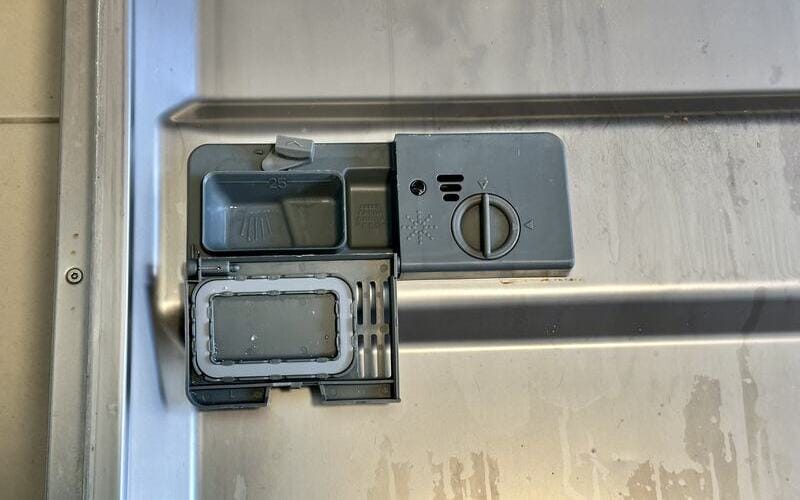
If there’s soap residue on the dishes or the dishwasher tub, you may have a broken soap dispenser!
For powder or liquid detergents, it’s likely the dispenser door isn’t releasing the detergent at the right time in the wash cycle. For dishwasher tablets, they’re likely not fully dissolving.
One common reason for a faulty dispenser is detergent or mineral build-up on the door latch/hinges.
How to fix it:
A mix of hot water and vinegar can break down stubborn build-up! Add a small amount into the dispenser and let it sit for 15-20 minutes.
Use a small brush and some detergent to scrub the interior of the dispenser, paying attention to any hinges and springs.
You can also check the manual for how to access the dispenser and check for any other mechanical problems. A small screwdriver may be able to open a stuck dispenser door.
If the spring, gasket, and latch are completely broken, replace them immediately.
6. Incorrect loading
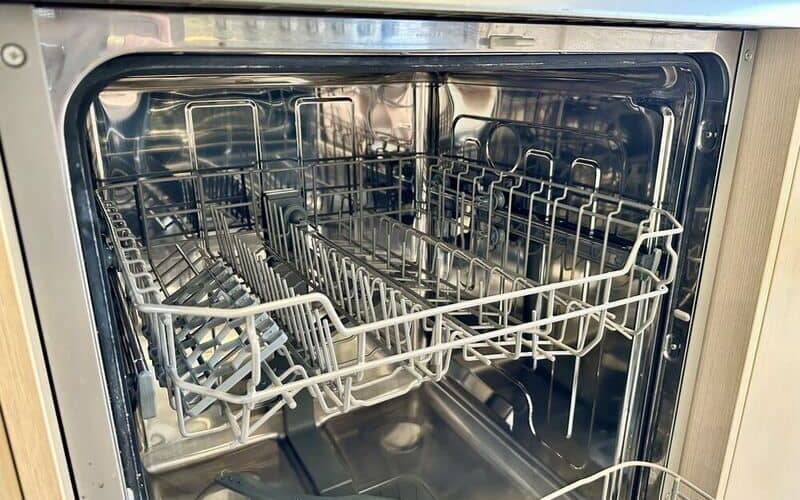
Believe it or not, overloading and misloading can have a great impact on your dishwasher not cleaning dishes!
Too many dishes can block the spray arms or prevent detergent from reaching all surfaces, resulting in dirty plates.
The same goes for improperly loaded or incorrectly positioned dishes.
How to fix it:
Load the dishwasher correctly!
Space out items properly to let the water and detergent circulate. Check the manual for recommended placements – some brands give instructions for where to put plates, glasses, and utensils.
Also, check that nothing is stopping the spray arm from spinning. If it can’t rotate freely, water won’t reach all your dishes.
TIP: Keep aluminium items away from glasses and other dishes to avoid black and grey marks!
7. Faulty water inlet valve
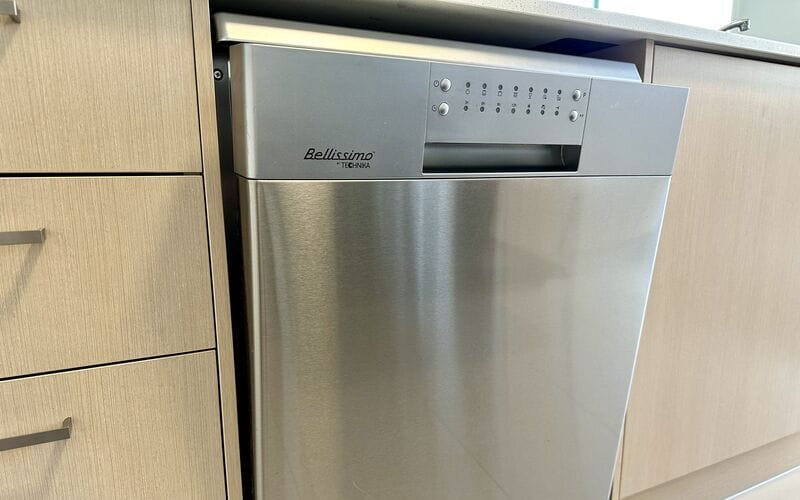
If your dishwasher isn’t filling up with enough water or you hear a hammering noise during the filling cycle, you may have a broken inlet valve.
The inlet valve controls the flow of water into the dishwasher. If it’s malfunctioning, there may not be enough hot water getting in.
How to fix it:
Check the inlet valve every 2-3 months to make sure it’s in good condition. You’ll usually find it near the access panel.
If there are any issues, consult the manual or call in a professional to handle the repair.
8. Water supply issues
Water pressure or volume are other factors for a dishwasher not cleaning your dishes.
If there’s low water pressure, the spray arm might not rotate properly, which leads to inadequate wetting or rinsing. The weak water flow can’t wash off the food deposits, grease, and grime.
How to fix it:
Inspect the water supply lines to ensure there are no kinks or obstructions.
If you find a problem, bring in a professional to help.
9. Low water temperature
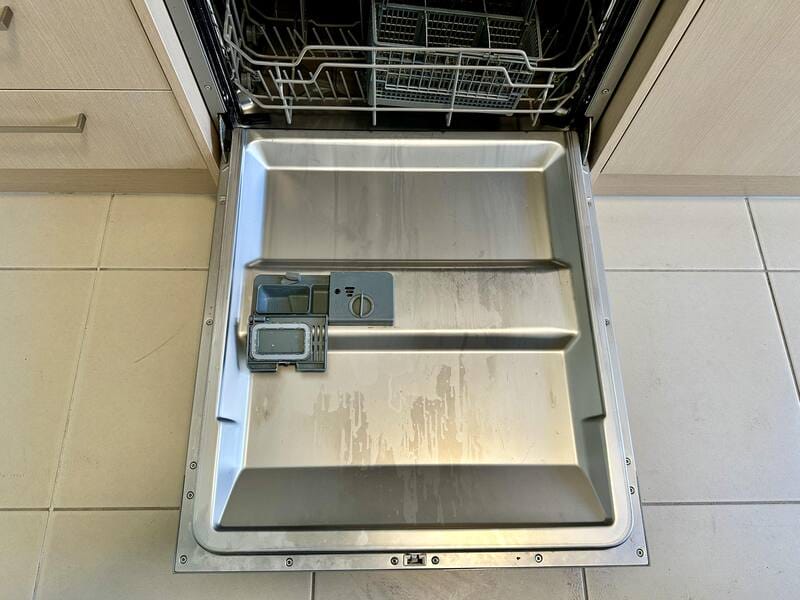
Hot water is essential for breaking down food particles and grease in your dishes.
If the water temperature is too low, it may not be able to clean your dishes effectively.
If too high, it can scald delicate items in your dishwasher.
How to fix it:
Check that your dishwasher is reaching the ideal temperature for wash cycles – at least 49ºC (120ºF). High-temperature dishwashers can get up to 66ºC (150ºF).
If you use a hot water tap or water heater, run the water for 30-60 seconds before you start a load. This ensures only hot water enters the dishwasher.
On the other hand, if your dishwasher has a heating element, inspect it for any issues.
You can also look at the thermostat nearby – if you see a zero reading, the heating element needs professional repair.
10. Wrong wash cycle
Many dishwasher models have different wash cycles depending on how many dishes you’re loading and how dirty they are.
If you pick the wrong setting – like a quick cycle for heavily soiled dishes – then you’ll be left with dirt and grime.
How to fix it:
Choose the appropriate cycle for the size of the load and the dirtiness of the dishes. You can check the manual for recommended settings.
TIP: If your dishwasher has auto mode, that makes things easier. Press that button and go!
Tips to Ensure Your Dishwasher Gets Dishes Clean
No one wants to worry about their dishwasher not cleaning!
Here are some tips to make sure your dishes come out sparkling every time.
Regularly clean the dishwasher
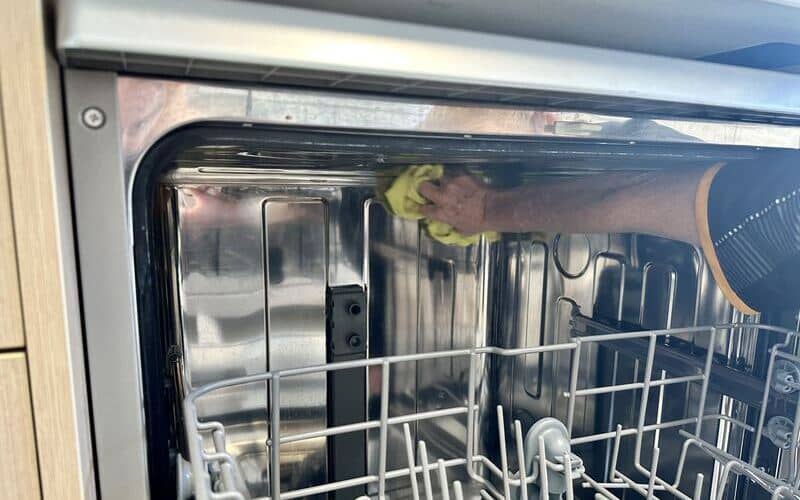
Regular dishwasher maintenance ensures the machine works efficiently and properly. Aim to clean the dishwasher once a month.
You can use soapy water, a vinegar cycle, or a commercial dishwasher cleaner.
Use the appropriate detergent
Choose the appropriate detergent for your dishwasher model, and follow the recommended amounts.
A rinse agent is optional, but can help!
Follow proper protocols
Check the manual for instructions on the correct settings and the right ways to load the racks.
Not only will this ensure your dishes come out clean, but it can extend the lifespan of your appliance!
Common Dishwasher Concerns
If you have more questions about why your dishwasher is not cleaning, we’ve got you covered!
Why is my dishwasher leaving residue even after cleaning?
If you find residue on your dishes after a dishwasher cycle, there are several reasons. Hard water deposits, a clogged spray arm, or a dirty filter are common causes.
For hard water, use the right detergent with a rinse aid. If possible, install a water softener on your intake line.
Regularly clean the arms, filter, and other parts to keep them working properly.
Why is my dishwasher not emptying properly?
If your dishwasher isn’t draining properly, it could be due to:
- Clogged drain
- Dirty filter
- Issues with the drain hose (e.g. obstructions or bends)
- Improper use of garbage disposal
- Failing drain pump
Check the components regularly, and clean or replace them as needed.
This way, you won’t find your dishes swimming in dirty water after washing.
Don’t Do Your Dishes Dirty
There you have it – your dishwasher doesn’t have to be a dish-misser!
By knowing what to check and how to fix things, you won’t panic if you find your dishwasher not cleaning dishes… and won’t have to pile everything into the kitchen sink.
Of course, you can always add on your dishwasher or the dishes when you book a professional home clean!

